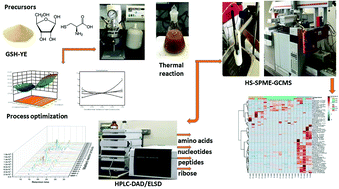Formation of beef-like odorants from glutathione-enriched yeast extract via Maillard reaction
Abstract
The application of yeast extract (YE) in foods has widely evolved in recent decades. Generally, YE is added to foods because of its characteristic meaty and savory flavor notes. The composition of YE has made it an important ingredient for the production of meat-like flavors. This study focuses on the simulation of beef-like odorants from yeast extract through the Maillard reaction. Additionally, an optimization process was conducted via the central composite design (CCD) to optimize the Maillard reaction conditions. Glutathione-enriched yeast extract (GSH-YE) was utilized as the precursor with the partial addition of cysteine and ribose to form beef-like aroma compounds. The key odorants generated through the Maillard reaction were characterized via HS-SPME-GCMS and the contents of the Maillard precursors were analyzed via HPLC. The optimized conditions produced numerous pyrazines, furans, thiazoles, and sulfur- and nitrogen-containing compounds responsible for mimicking beef-like aromas. 2,5-Dimethyl-furan, 2,5-dimethyl-pyrazine, thiazole, 2-methyl-3-furanthiol, dimethyl trisulfide, 3,5-diethyl-2-methyl-pyrazine, 3,3′-dithiobis[2-methyl-furan] and 2-methyl-3-(methylthio) furan were the predominant odorants generated through the Maillard reaction. Moreover, the individual effect of initial pH and thermal temperature showed dramatic changes in the overall volatile profile. The content of cysteine and other amino acids decreased rapidly at higher thermal temperatures. The amount of larger peptides (1500–5000 Da) decreased at a thermal temperature of 160 °C, while the contents of smaller peptides (<500) increased. Thus, the sensory and instrumental data validate the potential application of GSH-YE in generating beef-like odorants, and furthermore, these outcomes can aid future pragmatic studies for further insight into beef flavor chemistry.



 Please wait while we load your content...
Please wait while we load your content...